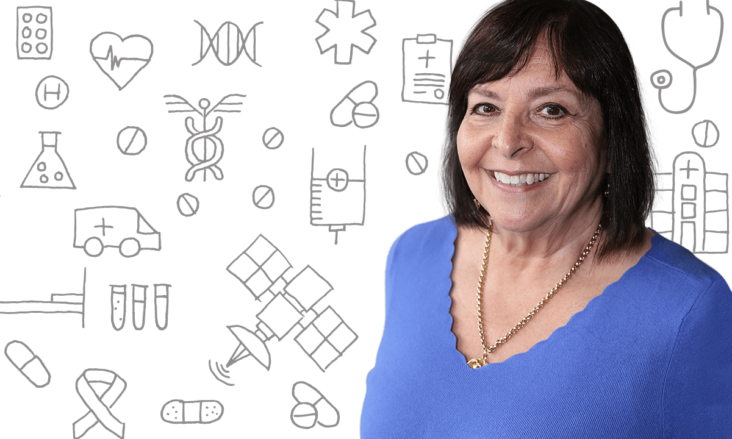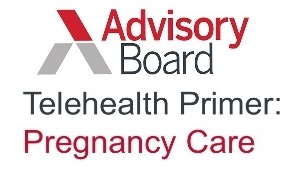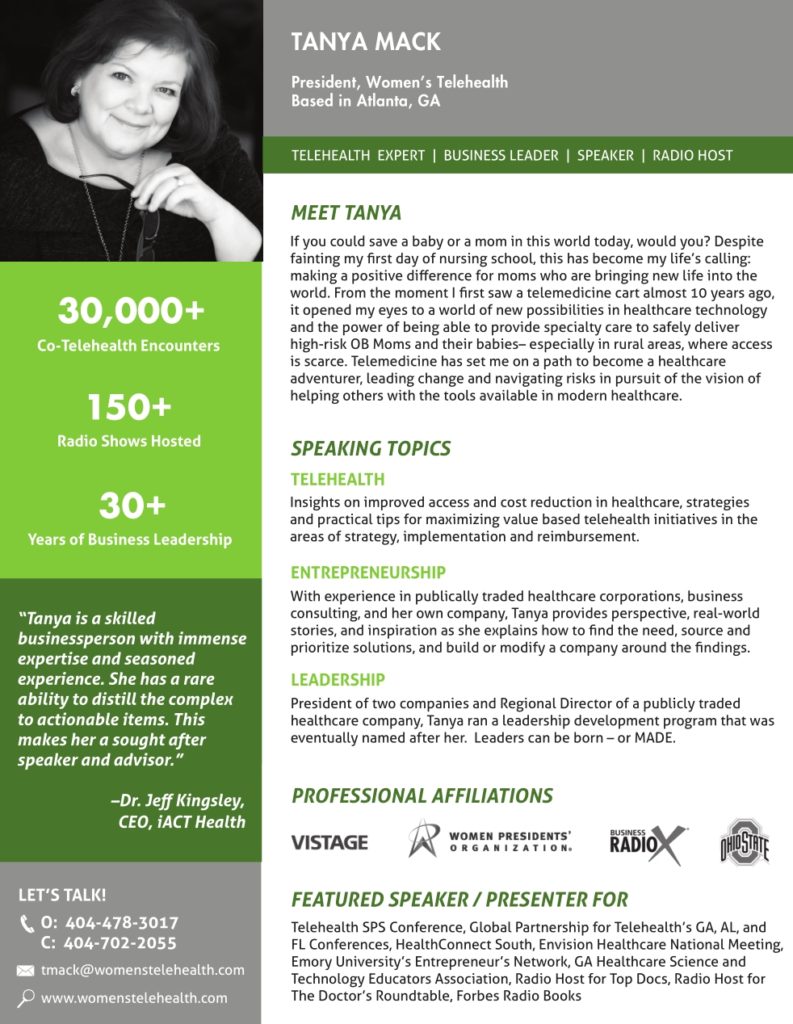Listen to the interview with Women’s Telehealth President Tanya Mack as she was a guest on the podcast “Really Know Your Customer”. Click the link below to hear how telemedicine has taken the medical field by storm.
Listen to the interview with Women’s Telehealth President Tanya Mack as she was a guest on the podcast “Really Know Your Customer”. Click the link below to hear how telemedicine has taken the medical field by storm.

Telemedicine — the delivery of healthcare via telecommunication technologies — has been around for decades. But it took an engineer to get it just right.
“We were doing telemedicine at NASA in the early 70’s, but it was completely ‘unsophisticated’ by current standards,” says Georgia Tach aerospace engineering alumna C. Anne Patterson, a board-certified OBGYN and CEO of the Sandy Springs-based Women’s Telehealth.
“We used a satellite to provide information about birth control that people in India could watch in between regular television programing,” remembers Patterson. “I was a propulsion engineer working on that satellite. Later, the satellite was re-purposed to send medical information to physicians in very remote areas of the Rocky Mountains. And that was the extent of our ‘telemedicine’ in the 70s.”
Four decades later, the telemedicine that Patterson now practices is much more than a medically-themed infomercial beamed down from a satellite. It is a systematic use of several technologies (including satellites), all with the goal of delivering personalized medical care directly to patients in remote areas. Telemedicine is also removing one of the largest barriers to health care delivery in the rural South: a chronic shortage of specialized medical practitioners.
“We’ve been able to set up clinics in seven southern states,” says Patterson. “We’ve reached more than 30,000 mostly low-income women — women who would not have access to maternal-fetal health. This is what modern telemedicine is capable of doing.”
Finding her Specialty
Patterson chose her medical specialty — maternal-fetal medicine — in part because it plays such a critical role in Georgia, which has some of the highest rates in the United States for maternal mortality and pre-term delivery, particularly among women of color.
“We conducted a study in Albany Georgia — an area that had preterm birth rates of 18 percent for African-American women, and 16 percent for Hispanic women,” says Patterson. “Those rates were the highest in the state. While it was a tough region to choose, everyone was receptive to trying something new to make a difference.” After bringing telemedicine into the area for 18 months, pre-term birth rates dropped to 8 percent and 6 percent respectively, which is lower than the national average. To date, the rates remain at this level or lower.
Telemedicine is uniquely suited to address the problems faced by the rural poor, Patterson points out. It does not involve high transportation costs, travel time, childcare, or Medicaid. With all of these barriers eliminated, patients are more likely to initiate and maintain contact with the medical system earlier in their pregnancies. Women’s Telehealth helps these high-risk patients to manage chronic health problems — like diabetes and hypertension — that could threaten their pregnancies.
In a typical consultation with Patterson, the conversation rarely ends when doctor and patient have checked off all the obvious medical issues, however. Before the video shuts down, Patterson leans into a more motherly consult with her patients, who have likewise relaxed their once-tense postures. At these moments, it’s a little easier to understand why Patterson is still seeing patients long past the point when most physicians would have retired.
Complete article go to: https://coe.gatech.edu/news/2019/11/engineer-inside-physician

As part of July Group B Strep Awareness Month, Women’s Telehealth encourages all pregnant women to make sure they complete their Group B Strep testing as part of routine prenatal care.
Group B Streptococcus (GBS) lives in the body naturally and it is a bacteria normally found in 25% of health adult women’s rectum or vagina. Women who test positive for GBS are considered “colonized” or a “carrier.”
GBS is not normally harmful to the mother, but can be harmful to the newborn. A pregnant woman can pass on this infection to the baby during delivery. Not every mom will have symptoms of a GBS infection and not every baby born to a mom with a GBS infection will become ill. While GBS disease can be deadly, there are steps pregnant women can take to help protect their babies.
The CDC recommends all pregnant women get tested for GBS between 35-37 weeks gestation. The most accurate results are within a 5 week period prior to delivery. The rectum and vagina are swabbed during the antepartum OB appointment and the sample is sent to the lab for processing. The results are usually available with a few days.
Rapid screen GBS tests are also available if a woman presents at a facility to deliver and has not had a GBS test completed. If a pregnant woman tests positive, treatment is considered.
Intravenous antibiotics (usually Penicillin for non-allergic patients) are given to women who are at increased risk of having a baby who will develop GBS disease. The antibiotics help protect babies from infection, but only if given during labor. Antibiotics are administered from the onset of labor and continue every 4 hours through to delivery.
The following symptoms may indicate a higher risk of delivering a baby with GBS:
If the baby is delivered via C-section and there is no labor or rupture of membranes, antibiotic treatment is not given. About 1 out of 200 babies of moms with GBS will contract the infection without IV antibiotic treatment. With IV antibiotic treatment, the incidence of babies contracting the infection is lowered to 1 in 4,000.
Early-onset GBS occurs when a baby is infected with GBS within the 1st week of life. Roughly half of babies born with GBS infection have early- onset symptoms including: sepsis, pneumonia, meningitis, breathing problems, heart rate and blood pressure instability and GI and kidney problems. In severe cases, stillbirth may result. Approximately 5% of babies with GBS infections at birth will die.
Late-onset GBS may occur after one week to several months of age. Signs of late-onset GBS include changes in your baby’s eating habits, such as feeding poorly, refusing to eat or not waking for feeding. Changes in baby’s skin, including blue, gray or pale skin due to lack of oxygen, or blotchy or red skin may also be signs of GBS. In the U.S., late-onset GBS has been the leading cause of meningitis in newborns in the first three months of life.
Although research is continuing, there is currently no vaccine for Group B Strep infection. The best two ways to prevent GBS during the first week of a newborn’s life are:
For additional information, please visit:
https://www.cdc.gov/groupbstrep/index.html or https://www.marchofdimes.org/complications/group-b-strep-infection.aspx
Don’t put your un-born baby at risk! Learn the facts and get tested!
~Tanya Mack, President

Virtual pregnancy care spans from prenatal to postpartum care. It incorporates a variety of telehealth modalities including audiovisual visits, remote patient monitoring and “live” and asynchronous store and forward imaging.
The Advisory Board is the best practice firm helping healthcare organizations worldwide improve their performance using a combination of research, technology and consulting. They have 12 offices on 3 continents and publish to over 9,000 healthcare organization outlets.
Recently, the Advisory Board published the piece, “Telehealth Primer: Pregnancy Care.” The publication features four innovative healthcare organizations using telehealth tools to deliver different aspects of pregnancy care and their business cases and results.
Women’s Telehealth is pleased to be featured in the primer for our work in providing maternal-fetal medicine services, delivered 100% via telemedicine, to help decrease preterm labor and improve access to maternal-fetal medicine providers.
The Mayo Clinic’s OB Nest program and the University of Utah were also featured in the Primer for their work in delivering antepartum visits virtually vs. in-person visits, to improve patient satisfaction with the same clinical outcomes.
The Primer also featured the University of Pennsylvania for delivering postpartum visits via remote patient monitoring to ease post-delivery care and outcomes for new moms.
For a copy of this informative primer, visit: https://www.advisory.com/research/service-line-strategy-advisor/resources/2018/telehealth-primer-pregnancy-care
Call me a healthcare adventurer! I’m always pursuing my vision to help others! Above all, my goal is to lead industry change with the tools available in modern healthcare.
I welcome your invitation to serve as a guest speaker or advisor! It would be an honor to share some of the varied expertise I’ve gained through seasoned experience. See bio for details.
~Tanya Mack, President


Renowned author Daniel Pink was a featured keynote speaker this week at the Women President’s Organization’s Annual Meeting in Charlotte, and Women’s Telehealth was there as he shook up the audience.
His main message was the far-reaching effects of information access available to almost anyone, anywhere, instantaneously. This playing field is leveled as we move through the world enrolling and influencing others around us. Information asymmetry is shifting to information parity.
To adjust to this shift, Dan suggested three strategies to consider- his version of the ABC’s:
Attunement: To get alignment, we must be more disciplined to understand another’s point of view.
Buoyancy: We must cultivate our ability to overcome “an ocean of rejection” and remain afloat in tough times.
Clarity: Expertise is now obsolete since we can choose to education ourselves for free online for almost anything. We have so much data at our fingertips, but now the need is the ability to sift through it and “problem find” and shift from accessing information to curating it.
As this shift rolls on, it will change our relationships, our work patterns, our productivity, our environments and our daily tools. Whether we like it or not, Dan tells us 41% of our day AT LEAST is spent influencing or persuading in some way.
Time to make some adjustments?
~Tanya Mack, President

Beginning, July 1st, CareSource, an Ohio based Care Management Organization (CMO) will expand into the Georgia market and begin serving a portion of Georgia’s 1 million Medicaid consumers and become the state’s 4th CMO. They will share an over $4B agreement over the next 6 years with GA’s other CMO providers.
They are unique already as they are the only GA CMO that is non-profit, their top leader is a woman and they are poised to bring some innovative
programs to the Georgia market. Listen in as Women’s Telehealth speaks to top Caresource leaders and hears about their plans: http://topdocs.businessradiox.com/shows/caresource

Check out our Top Docs radio show with our own Dr. Anne Patterson discussing women’s health as part of National Women’s Health Week! Dr. Anne Patterson discusses steps women can take to improve and maintain their health throughout their lives and preventive screenings for women. Click here to listen: http://topdocs.businessradiox.com/…/…/23/womens-health-week

Our latest Top Docs BusinessRadioX show features Cat Rye speaking about Idiopathic Hypersomnia. This week is Sleep Awareness Week – “Sleep Better, Feel Better.” http://topdocs.businessradiox.com/2017/04/25/idiopathic-hypersomnia/

Check out our latest @TopDocsOnBRX radio show with Dr. Gregg Raduka, Director at The Council of Alcohol and Drugs discussing Alcohol Awareness month and abuse prevention: http://topdocs.businessradiox.com/2017/04/10/alcohol-awareness-month/